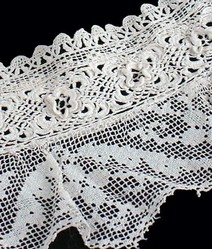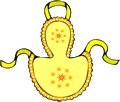One of the most well known products of 19th century Ireland is handmade lace. While men worked at their trades or in the fields farming, many Irish women made lace to help support their families, selling the lace itself, or incorporating it into clothing, accessories or home decor. Making the lace was an extension of the needlework that most Irish women could already do to create clothing for their families, so when money was needed, creating lace made sense to earn income.
There are several types of antique Irish lace, although many of them are no longer being made today. Some of these types are Kenmare lace, Irish crochet, Carrickmacross lace, Youghal lace, and Limerick lace, each named after the part of Ireland that the lace came from.
Vintage lace, if packaged well, can last a very long time, because it is not as fragile as it looks. And if the lace was only used for special occasions, it was not exposed to dirt, dust, and air to discolor it. The most common Irish lace to find are small accessories like gloves, collars, or doilies which would have been easier both to make, and to maintain over the years. Even these small touches can make a huge difference in the look of an outfit or table decoration, and if you are a clothing designer, adding a lace collar or cuff to a dress or blouse can take if from ordinary to extraordinary or one of a kind.







 Best Father-to-be Bookson 06/04/2013
Best Father-to-be Bookson 06/04/2013
 Gothic Garden - Black Flowerson 05/20/2011
Gothic Garden - Black Flowerson 05/20/2011
 Leatherwork: The Art of Working with Leatheron 03/14/2013
Leatherwork: The Art of Working with Leatheron 03/14/2013
 Contemporary Desk Lamps for Home or Officeon 08/29/2012
Contemporary Desk Lamps for Home or Officeon 08/29/2012



Comments
Lace is just so beautiful. I love it and have several pieces. I enjoyed your article and the lovely lace :)
I've been looking for a crochet pattern for a wedding veil. Irish lace would be great for that. Let me know if you run into any. Thanks for the article.